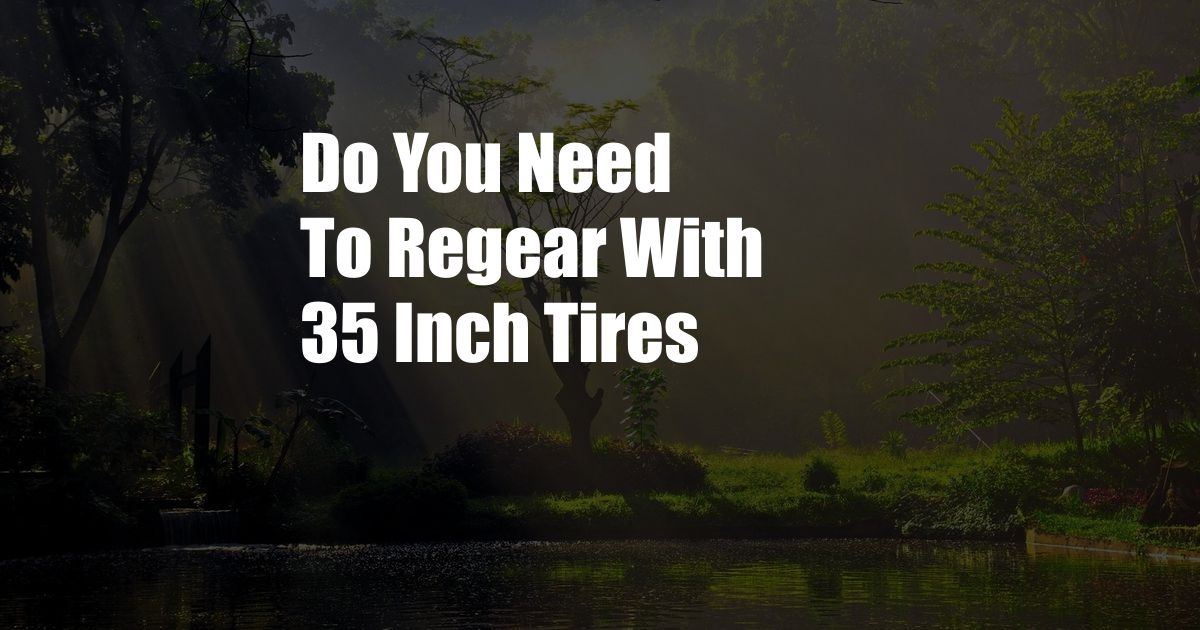
Do You Need to Regear with 35 Inch Tires?
I recently upgraded my Jeep Wrangler to 35-inch tires, and I couldn’t be happier with the results. The increased ground clearance and traction have made a huge difference in my off-road adventures. However, one question that I had to answer before making the switch was whether or not I needed to regear my Jeep.
Regearing is the process of changing the gear ratio in your differential to match the new tire size. This is necessary because larger tires will change the final drive ratio, which can affect the performance of your vehicle. In general, you will need to regear if you go up or down in tire size by more than 2 inches.
What are the Benefits of Regearing?
There are several benefits to regearing your vehicle after installing larger tires.
- Improved performance: Regearing will help your vehicle to maintain its original performance levels, even with larger tires. This means that you will have the same acceleration and towing capacity as before.
- Reduced fuel consumption: Regearing can actually help to reduce fuel consumption by optimizing the engine’s RPM range. This is because a properly geared vehicle will not have to work as hard to maintain a given speed.
- Increased towing capacity: If you plan on towing a trailer, regearing is a must. This is because larger tires will reduce your vehicle’s towing capacity, and regearing will help to restore it.
What are the Costs of Regearing?
The cost of regearing will vary depending on the type of vehicle you have and the gear ratio you choose. However, you can expect to pay between $1,000 and $2,000 for the parts and labor.
Is Regearing Right for You?
Whether or not you need to regear your vehicle after installing larger tires depends on several factors.
- The type of vehicle you have: Some vehicles are more sensitive to changes in tire size than others. For example, Jeep Wranglers are known for being able to handle larger tires without regearing, while other vehicles may not.
- The size of your tires: The larger the tires you install, the more likely you will need to regear. This is because larger tires will change the final drive ratio more than smaller tires.
- Your driving habits: If you do a lot of off-roading or towing, you may benefit from regearing. This is because regearing will help to improve your vehicle’s performance in these situations.
Tips for Regearing Your Vehicle
If you decide to regear your vehicle, here are a few tips to keep in mind:
- Do your research: Before you start shopping for gears, take some time to research the different options available. This will help you to choose the right gear ratio for your vehicle and driving habits.
- Find a reputable mechanic: Regearing is a complex process that should be performed by a qualified mechanic. Ask around for recommendations or read online reviews to find a mechanic who has experience with regearing.
- Be prepared for downtime: Regearing can take several hours or even days to complete. Make sure to plan ahead and arrange for a ride or rental car if necessary.
FAQ
Q: Do I need to regear my Jeep with 35-inch tires?
A: It depends on several factors, including the type of Jeep you have, the size of your tires, and your driving habits. In general, you will need to regear if you go up or down in tire size by more than 2 inches.
Q: How much does it cost to regear a Jeep?
A: The cost of regearing a Jeep will vary depending on the type of Jeep you have and the gear ratio you choose. However, you can expect to pay between $1,000 and $2,000 for the parts and labor.
Q: Can I regear my Jeep myself?
A: Regearing is a complex process that should be performed by a qualified mechanic. If you are not experienced in working on vehicles, it is best to leave this job to a professional.
Conclusion
Regearing your vehicle after installing larger tires can improve performance, reduce fuel consumption, and increase towing capacity. However, it is important to do your research and find a reputable mechanic to perform the job. If you are not sure whether or not you need to regear your vehicle, consult with a mechanic to discuss your options.
Are you interested in learning more about regearing?